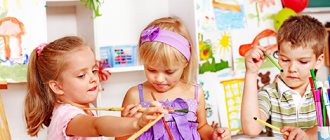Difficulties and questions
I have already raised this topic in the article “Self-analysis of a teacher: how to compose it correctly?”, but despite the presence of many methodological recommendations in the literature and the Internet, my colleagues, especially young ones, have difficulties in this matter. I've talked before about the general self-reflection that goes into a portfolio. And today I will write about self-assessment of any activity that is conducted in kindergarten.
It should be understood that such documents are like a professional autobiography, but not just listing reliable information about periods of life, but with an analysis of mistakes and achievements. A self-respecting teacher will make every effort not to submit a poorly compiled analysis of the work done to management for review.
If you ask a truly adequate methodologist what he or she wants to see as a self-analysis of the lesson, then I am sure he or she will answer the following: “I want to read a logically structured, competent, reasonable self-analysis, supported by specific facts.” Do you, colleagues, think I understand the requirements for this document correctly? Respond, dear teachers!
It is no secret that even experienced educators, who will carry out any event with a bang, when writing an analysis then stumble on the wording of sentences. I’m like that myself, although I have to write a lot of things both at work and on the blog. But here natural laziness helps me: in order not to do extra work every time, I worked hard once, but made a kind of matrix - a sample for myself and now I will share it with those who need help.
Self-analysis of classes at preschool educational institutions
We have offered you a lesson on speech development in the preparatory group on the topic: “Retelling the story by V. Bianchi “Bathing the Bear Cubs.”
I set a goal: developing the skills of a coherent, sequential retelling of text based on graphic diagrams.
The purpose of the lesson is aimed at solving the following problems:
Strengthen children’s ability to listen carefully to a literary text and answer questions about the content.
Develop the ability to explain the meaning of words, come up with graphic diagrams, practice the formation of nouns with diminutive suffixes; develop memory, attention, thinking.
Foster a culture of behavior, friendliness, and respect for each other.
All requirements for conducting the lesson were met.
Educational activities took place in a clean, ventilated, well-lit room.
The duration of the lesson corresponds to the norms for children of this age - 30 minutes.
Children were not allowed to become overtired due to alternating types of activities (conversation, standing on the carpet, game “Name it kindly,” sitting listening to a story, physical education, drawing diagrams, retelling).
General educational and developmental goals and objectives, the level of development of students, their age characteristics.
Integration of educational areas in accordance with the age capabilities and characteristics of students in the classroom is implemented through appealing to the experience of children in other educational areas (cognitive development, social and communicative development)
An approximate sample of the design and content of the analysis of GCD in a preschool educational institution
Group
01 senior preparatory, speech therapy
Subject
: consolidate knowledge of geometric shapes, counting to 10, the relationship between number and quantity, the ability to use a measure, the development of visual and auditory attention, logical thinking, the ability to compare and generalize. Cultivate a positive attitude towards the lesson, develop cooperation skills.
Setting the goal of the lesson (activity)
CONCLUSIONS:
The lesson completely achieved its goal. Working with children is systematic, consistent, and effective. ensures standard levels of development and education of children in accordance with the current program, effectively uses modern didactic methods. Establishes close contact with students and knows how to solve pedagogical problems.
The purpose of the lesson was communicated to the children, was clear to them and corresponded to the content of the lesson. The selected methods and techniques corresponded to the age of the children and were selected taking into account their individual characteristics (state of attention, degree of fatigue, etc.). Visual and verbal instructions were presented accurately and clearly. Throughout the lesson, the teacher provided assistance in the form of: advice, questions of various types (direct, leading, prompting), and used additional visual supports (pictures). The stages of the lesson were interconnected and sequential.
Throughout the entire lesson, the children maintained their interest, which was facilitated by the dynamics of the lesson. All tasks were chosen competently and contributed to the development of mental functions (attention, memory, thinking), developed independence, experience of self-control, and the ability to evaluate peers.
A favorable emotional background was created during the lesson; the teacher’s speech was emotional in communicating with the children. Colorful handouts were selected (houses for figures, numbers). The children's correct answers were encouraged by the teacher, which gave them confidence.
The lesson complied with sanitary and hygienic standards and health requirements (the teacher monitored the correct seating of the children, the lighting of the room, etc.).
The only disadvantage of the lesson is the duration (too long in duration) due to the large amount of individual work with each child.
Organization of children's actions to accept the goal of the activity
Compliance of the content of the educational material with the stated goal
Training methods provided:
Collaboration between children and children
Organizing children to achieve their goals
Compliance of teaching methods with the content of educational material and the purpose of the lesson
Forms of organization of cognitive activity provided:
Cooperation between children
Inclusion of each child in activities to achieve the didactic goal
Variety of activities
Forms of organization of cognitive activity are selected in accordance with teaching methods, content of educational material, didactic purpose
Goal achievement level:
Head of MDOU No. 2**** N.A. Directorova
I have read and agree ___________ _________________
Group
01 senior preparatory, speech therapy
Teacher speech therapist
Govorilkina Yu.G.,
Subject
: Vegetables, fruits, berries.
Setting the goal of the lesson (activity)
CONCLUSIONS:
The lesson completely achieved its goal. Working with children is systematic, consistent, and effective. ensures standard levels of development and education of children in accordance with the current program, effectively uses modern didactic methods. Establishes close contact with students and knows how to solve pedagogical problems.
The purpose of the lesson was communicated to the children, was clear to them and corresponded to the content of the lesson. The selected methods and techniques corresponded to the age of the children and were selected taking into account their individual characteristics (state of attention, degree of fatigue, etc.). Visual and verbal instructions were presented accurately and clearly. Throughout the lesson, the teacher provided assistance in the form of: advice, questions of various types (direct, leading, prompting), and used additional visual supports (pictures). The stages of the lesson were interconnected and sequential.
Throughout the entire lesson, the children maintained their interest, which was facilitated by the dynamics of the lesson. All tasks were chosen competently and contributed to the development of mental functions (attention, memory, thinking), developed independence, experience of self-control, and the ability to evaluate peers.
The lesson complied with sanitary and hygienic standards and health requirements (the teacher monitored the correct seating of the children, the lighting of the room, etc.).
The only disadvantage of the lesson is the duration (too long in duration) due to the large amount of individual work with each child.
Organization of children's actions to accept the goal of the activity
Compliance of the content of the educational material with the stated goal
Training methods provided:
Collaboration between children and children
Organizing children to achieve their goals
Compliance of teaching methods with the content of educational material and the purpose of the lesson
Forms of organization of cognitive activity provided:
Cooperation between children
Inclusion of each child in activities to achieve the didactic goal
Variety of activities
Forms of organization of cognitive activity are selected in accordance with teaching methods, content of educational material, didactic purpose
Goal achievement level:
I have read and agree ___________ _________________
Group
01 preparatory, speech therapy
Subject
: Vegetables, fruits, berries.
Setting the goal of the lesson (activity)
The theme of the GCD corresponds to a comprehensive thematic planning developed taking into account the preschool education program “From birth to school”, the correctional part of which is based on the system of work in a speech therapy group for children. Based on the topic, goals were formulated and the content of the educational activity was selected taking into account the age characteristics of children and their speech profile.
The set goals and objectives are implemented in a complex type of activity, in a subgroup form. Achieving the goals of GCD was carried out through the unity of correctional-educational, correctional-developmental and correctional-educational tasks.
The abstract, from the point of view of known ways of developing new techniques, represents the application of the created experience with elements of modification in new conditions.
Let's look for answers on the Internet...
I will not change the established tradition - to make for you a selection of useful, in my opinion, books and manuals.
So, after searching in UchMag, I found something special:
A bestseller in popular psychological literature, a book by an outstanding woman – Karen Horney “The Psychology of Women”. The language of the book is relaxed, funny, the topic is relevant for representatives of the weaker sex, so to speak - how to overcome internal conflicts and how to recognize the psychotype of the people around you. In addition, the author publishes a unique technique - an example of personal introspection. I think this is a very interesting book that will be useful to any woman.
As for professional activities, I advise you to pay attention to the electronic manual “Performance Map of the Professional Activities of a Teaching Worker.” This is a CD with guidelines for creating self-reflections, portfolios, etc.
The printed manual “Self-analysis of the educational process: analytical activity, structure and content” is intended for heads of educational institutions to provide a scientifically based system of activity and management.
I understand that I haven’t presented you with many manuals on the issue of step-by-step compilation of self-analysis for a lesson, but I have already written and recommended thematic manuals on this topic several times, but I don’t want to repeat myself.





